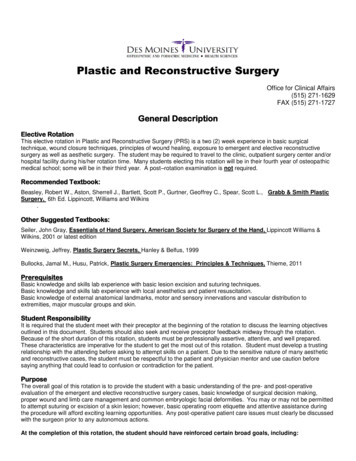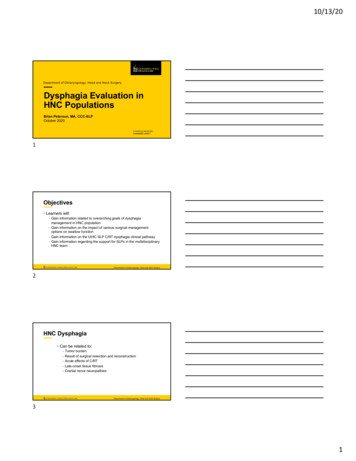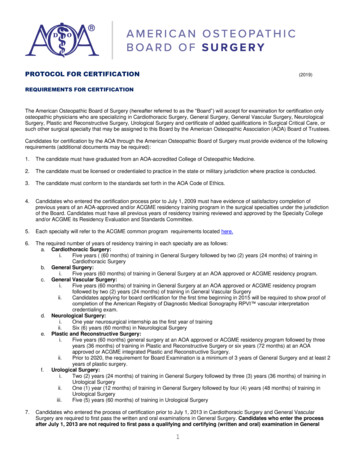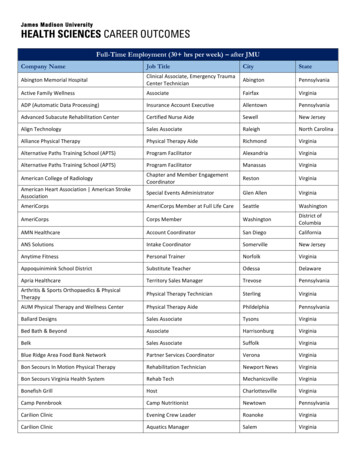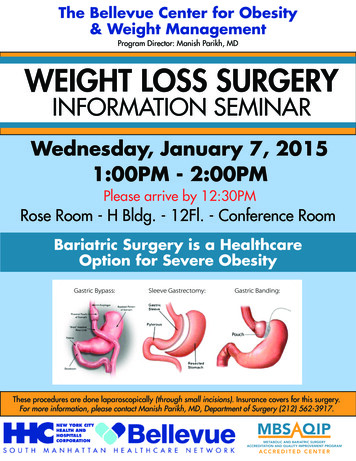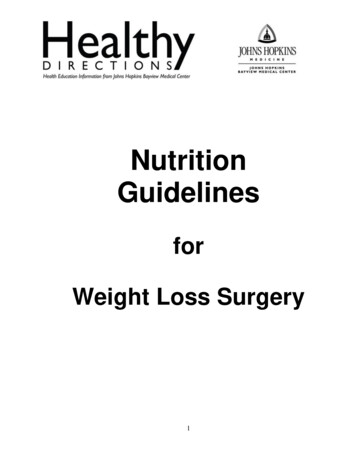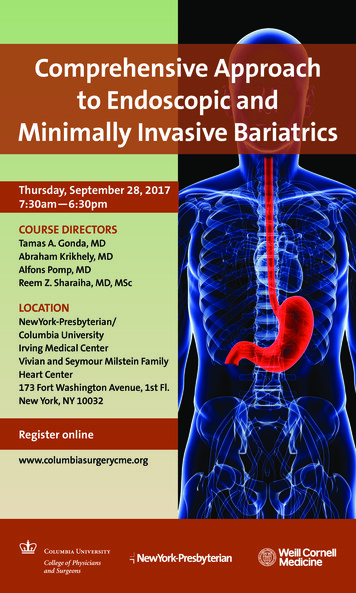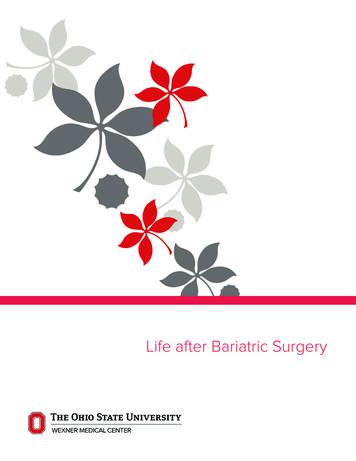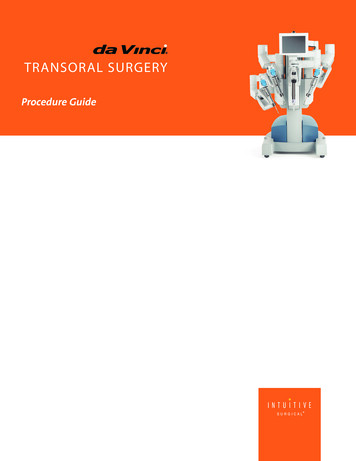
Transcription
TRANSORAL SURGERYProcedure Guide
da Vinci Transoral SurgeryProcedure GuideTABLE OF CONTENTS:1. Introduction da Vinci Transoral Surgery (TORS)2. Instruments & Accessories OR equipment and robotic supplies Recommended EndoWrist Instruments Recommended non-robotic instrumentation Recommended mouth gags/retractors Recommended sutures Supplies for postoperative care3. Patient Selection, Patient Positioning and System Docking Patient Selectiono Patient types for early caseso Contraindications OR Configurationo Overhead view Patient Preparationo Anesthesia setupo Patient positioning and OR table considerations da Vinci Setup and Dockingo System setupo Camera arm and instrument arm docking4. Procedure Exampleso Surgical site exposureo Resection methodsA. da Vinci TORS Radical TonsillectomyB. da Vinci TORS Supraglottic Partial Laryngectomy5. Post-Operative Careda Vinci Transoral Surgery Procedure GuidePN 871671 Rev. A 8/081
DisclaimerThe following material has been reviewed and approved by independent surgeons, who arenot Intuitive Surgical employees:Gregory Weinstein, MDProfessor and Vice ChairmanThe University of Pennsylvania Health SystemDepartment of Otorhinolaryngology - Head and Neck SurgeryPhiladelphia, PABert W. O'Malley Jr., MDGabriel Tucker Professor and ChairmanThe University of Pennsylvania Health SystemDepartment of Otorhinolaryngology - Head and Neck SurgeryPhiladelphia, PAThis procedure guide is provided for general information only and is not provided as formalmedical training or certification. Intuitive Surgical trains only on the use of the da VinciSurgical System. Intuitive Surgical does not provide clinical training nor does it provide orevaluate surgical credentialing or train in surgical procedures or techniques. This materialpresents the opinions of and techniques used by the above surgeons and not those ofIntuitive Surgical. Before performing any clinical procedure utilizing the System, physiciansare responsible for receiving sufficient training and proctoring to ensure that they have therequisite training, skill and experience necessary to protect the health and safety of thepatient.For technical information, including full cautions and warnings on using the da Vinci System,please refer to the System User Manual. Read all instructions carefully. Failure to properlyfollow instructions, notes, cautions, warnings and danger messages associated with thisequipment may lead to serious injury or complications for the patient.While clinical studies support the use of the da Vinci Surgical System as an effective tool forminimally invasive surgery, outcomes cannot be guaranteed, as surgery is patient andprocedure specific.The use of the da Vinci Surgical System for Transoral Surgery has not been cleared by theU.S. Food and Drug Administration. 2008 Intuitive Surgical. All rights reserved. Intuitive , Intuitive Surgical , da Vinci , daVinci S , InSite , TilePro and EndoWrist are trademarks or registered trademarks ofIntuitive Surgical. All other product names are trademarks or registered trademarks of theirrespective holders. PN 871671 Rev. A 8/082da Vinci Transoral Robotic Surgery Procedure GuidePN 871671 Rev. A 8/08
1. Introductionda Vinci Transoral Surgery (TORS) is perhaps the most effective minimally invasive surgicaltreatment for diseases of the head and neck available today. The da Vinci Surgical System(standard and S models) allows the surgeon to provide the patient with proceduresequivalent to traditional transoral surgery, but with the advantage of 3D high-definitionvisualization of the laryngopharyngeal structures, and the precision and dexterity affordedby robotic instrumentation. Additionally, da Vinci TORS allows the performance ofendoscopic procedures that otherwise would be performed through an open approach,therefore minimizing morbidity and improving functional outcome as compared to an openapproach.Potential Patient BenefitsWhen compared to other surgical approaches, da Vinci Transoral Surgery may offer thepatient numerous potential benefits, including:o Avoidance of disfiguring mandibulotomyo Minimization or elimination of need for chemoradiation therapy1,2o Avoidance of tracheostomy1o Quicker return to normal speech and swallowing2o Significantly less pain1o Less blood loss1o Less risk of wound infection1o Shorter hospital stay1o Shorter recovery time1o Minimal scarring1Potential Surgeon Advantageso General Advantages Enhanced 3D HD visualization allowing precise dissection With the angled telescopes and wristed instrument, issues of line-of-sightrequired for standard microscopic transoral laser surgery are eliminated Maximum preservation of function and enhanced definition of safe margin forcomplete tumor removal da Vinci technology provides enhanced possibility to adapt the surgicalprocedure to the intraoperative findings without compromising oncologicalprinciples Tremor-free laser probe application available as an alternative toelectrocautery, when indicatedo Advantages Specific to da Vinci Transoral Surgery (TORS) Avoidance of significant morbidity of a translabial mandibulotomy, including lipand chin scars in selected cases Avoidance of the need for combined chemotherapy and radiation in selectedcases1O’Malley BW, Weinstein GS, Snyder W, Hockstein NG. Transoral robotic surgery (TORS) for base of tongue neoplasms. Laryngoscope. 2006Aug;116(8):1465-722Weinstein GS, O'Malley BW Jr, Snyder W, Sherman E, Quon H. Transoral robotic surgery: radical tonsillectomy. Arch Otolaryngol HeadNeck Surg. 2007 Dec;133(12):1220-6.da Vinci Transoral Surgery Procedure GuidePN 871671 Rev. A 8/083
Potential to improve swallowing function due to added surgical precisionAvoidance of malocclusion and chronic aspiration in selected casesPotential to avoid tracheostomyVisualization and reach of deepest structures with robotic instrumentsTransoral suturing capability for enhanced reconstruction capabilityda Vinci TORS applicationsThe main anatomical areas for which TORS may be applied to a wide variety ofprocedures are:*o Oropharynx and skull base Tonsil Tongue base Palate Pharyngeal wall Parapharyngeal spaceo Larynx and hypopharynx Supraglottis Glottis Pyriform sinus Pharyngeal wall*This list is limited to those anatomical areas that have been reported in the literature.This procedure guide will use an example procedure in the oropharyngeal and laryngealarea to detail the variations in da Vinci System setup. The patient positioning, da VinciSystem setup and instrumentation is similar for all procedures performed in oneanatomical area. Once the surgeon has familiarity with the proper setup for each of theareas, setup for procedures not described in this procedure guide should be apparent tothe surgeon.Portions of this procedure guide are synopsized from the book Transoral Robotic Surgery(TORS), G. Weinstein and B. O’Malley, Plural Publishing, San Diego, CA.(www.pluralpublishing.com/publications tors.htm)4da Vinci Transoral Robotic Surgery Procedure GuidePN 871671 Rev. A 8/08
2. Instruments & Accessories OR equipment and robotic supplieso Equipment that must be available in room: Warming blanket (Bair Hugger) Cautery unit (set at 15-20 W for COAG) with Bovie pedal and bipolarpedal - one pedal next to assistant for suction cautery Two Bovie pads Reusable bipolar cord Intuitive Surgical high-magnification camera head (45 FOV) Intuitive Surgical wide-angle camera head (60 FOV) Ikegami high-definition 3D imaging system (da Vinci S only) 30 degree Intuitive Surgical endoscope 0 degree Intuitive Surgical endoscope Surgical headlight Three chairs that have a foot pedal for adjusting up and down - two atbedside (for the nurse and the bedside surgical assistant) and one atsurgeon console Three rectangular OR instrument carts and one small square ORinstrument carto Medications/pharmacologicals:o Methylene Blue – for marking margins on specimeno Afrin – for topical application transorallyo Topical hemostatic agent Surgiflo – Agent (Baxter Healthcare) for topical hemostasis or FloSeal - (Johnson and Johnson, New Brunswick, NJ) for topicalhemostasiso Recommended 5mm EndoWrist Instrumentation:o One Monopolar Cautery, PN 400142/420142 with Hook Tip, PN 400156 with Spatula Tip, PN 400160o Two Needle Drivers, PN 400117/420117da Vinci Transoral Surgery Procedure GuidePN 871671 Rev. A 8/085
o One DeBakey Forceps, PN 400145/420145o One Round-Tip Scissors, PN 400141/420141o One Curved Scissors, PN 400146/420146o One 5Fr Introducer Instrument (for laserapplication), PN 400225/420225o 1 Maryland Dissector, PN 400143/420143o 2 x 5mm Flared Cannula, PN 420262, da Vinci S onlyo Alternative 8mm EndoWrist Instrumentation:o Fenestrated Maryland Bipolar, PN 400172/420172o Large Needle Driver, PN 400006/420006o DeBakey Forceps, PN 400036/420036o Round-Tip Scissors, PN 400007/420007o Permanent Cautery Spatula, PN400184/4201846da Vinci Transoral Robotic Surgery Procedure GuidePN 871671 Rev. A 8/08
ooRecommended non-robotic instrumentation:Qty. Product DescriptionCatalog 82-B50-703016-2310Weder Tongue DepressorRight Clip ForcepsLeft Clip ForcepsRegular Metzenbaum 7" Scissor8" [Long Suture] Sims Scissor9" Vascular Needle Driver6¼" [Kelly] Rochester - Pean7¼" [Criles] Schmidt ClampsCurved AllisTowel Clips-Non Penetrating 3½"Penetrating Towels Clips 5.5"Blue Burner [9½ Pilling Insulated]Velvet Eye Laryngeal SuctionBaby Yankauer SuctionManufactureror VendorGyrusKarl StorzKarl StorzCodmanCodmanPillingCodmanCodmanKarl StorzCodmanCodmanPillingPillingPillingRecommended mouth gags/retractorsThe main consideration when choosing a mouth gag or retractor for da Vinci TORS iswhether the device provides adequate exposure to the anatomical structures withoutcompromising the workspace necessary for the da Vinci System arms and instruments.o Feyh-Kastenbauer (FK) RetractorThe FK-Laryngo-Pharyngoscope System (Feyh-Kastenbauer Retractor) from GyrusACMI (www.gyrus-ent.com)/Explorent GmbH, Tuttlingen Germany(www.explorent.de) offers significant potential advantages with its lateralretractor attachments and its variety of tongue blades. The “cutout” blades andvallecular blade of the FK with three-dimensional adjustment capability providethe most versatility for achieving ideal exposure, and it is therefore therecommended retractor system for da Vinci TORS for exposure of thehypopharynx, larynx and — at times — for tongue base exposure.da Vinci Transoral Surgery Procedure GuidePN 871671 Rev. A 8/087
Qty.Product Description1FK Basic Frame (Feyh-Kastenbauer)Attachment for connection of frame to chestsupportTongue Blade Curved 22cm (for all applications)Tongue Blade Curved to Right, 22cmTongue Blade Curved to Left, 22cmCheek Retractor, flexible, 22.5cmWollenberg Laryngeal Blade, concave, 17cmWollenberg Diverticuloscope Blade, concave, 22cmSimon Mandible Blade, 14cm11112111Catalog No. Manufactureror Gyruso Crow-Davis Mouth GagUtilized for oropharyngeal exposure; the primary retractor for the exposure of thetonsillar region and the tongue base. The mouth gag listed below allows for widermouth opening than other products.oQty.11111The Storz tongue blades listed below feature integrated suction tubing for smokeevacuation. (www.storz.com, www.karlstorz.com )Product DescriptionCrow-Davis Mouth Gag RightCrow-Davis Mouth Gag LeftDavis-Meyer Tongue Blade size 2.5Davis-Meyer Tongue Blade size 3Davis-Meyer Tongue Blade size 3.5Catalog No.N7451N7550743925743930743935Manufacturer orVendorBausch & Lomb/StorzBausch & Lomb/StorzKarl StorzKarl StorzKarl Storzo Dingman Mouth GagUtilized for oral cavity r/vmcatalog/vmueller.html)Qty.1111oProduct DescriptionDingman Mouth Gag FrameDingman Mouth Gag Blade No.1, 2 ½" x 1"Dingman Mouth Gag Blade No.2, 2 ¾" x 1¼"Dingman Mouth Gag Blade No.3, 3 ¼" x 1¼"Catalog No.MO130-001MO130-002MO130-003MO130-004Additional mouth gagsQty. Product Description1Jennings Mouth Gag1Side Biting Mouth Gag/Sluder Jansen Mouth Gag8Manufactureror VendorV. MuellerV. MuellerV. MuellerV. Muellerda Vinci Transoral Robotic Surgery Procedure GuideCatalog No.7020270232PN 871671 Rev. A 8/08Manufactureror VendorPillingPilling
oAdditional equipment for mouth gag applicationo Metal holding arms that mount on the OR table to support mouth gag retractor:o 2x holding system w/ articulated stand (PN28172HA), socket (PN28172HK) andflexible clamping jaw (PN28172KFA) or clamping jaw instrument (PN28172KSA)(all at www.karlstorz.com)o Laryngoscope Holder and Chest Support for Adults (8575 GK) (www.karlstorz.com)oRequired sutureso 2-0 PermaHand Silk, SH needle (Ethicon Inc., http://ecatalog.ethicon.com)oro 2-0 Sofsilk, V-20 needle (www.syneture.com)o 3-0 Vicryl Coated, SH needle (Ethicon Inc., http://ecatalog.ethicon.com) oro 3-0 Polysorb, V-20 needle (www.syneture.com)oOperating room disposableso Plastic Yankauer suctiono Suction tubing (three)o Tonsil spongeso Steri-Drape Instrument Pouch – (www.3M.com)o Disposable suction coagulator – 11.00" (www.aemedical.com) (Catalog # - 050-035)o Optigard Eye Protection Goggles – (www.dupacoinc.com ) (Catalog # - 28310)o Clips for use with forceps 8665LR, Titan LT 200: medium, 5 mm, sterile, box with36 cartridges, 6 clips each (8665T) (www.karlstorz.com) Supplies for postoperative careo No da Vinci TORS-specific supplies necessaryo Usual post-operative regimen for transoral microsurgical surgery per individualhospital standardsda Vinci Transoral Surgery Procedure GuidePN 871671 Rev. A 8/089
3. Patient Selection, Positioning and Dockingo Patient types for early cases:o Choose an early tonsillar or supraglottic case initially with a localized lesionwithout extensive involvement of surrounding structureso Indicationso Patients must present with indications for diagnostic or therapeutic approaches forbenign and malignant diseases of the oral cavity or laryngopharynxo Contraindicationso The standard contraindications for head and neck surgery, both conventional andminimally invasive, should be practiced when selecting patients for transoralrobotic procedures including:o The presence of medical conditions contraindicating general anesthesia ortransoral surgical approacheso Inability to adequately visualize anatomy to perform the diagnostic ortherapeutic surgical approach transorally (methods for preoperativevisualization are specific to site and procedure and are available either inthe text below or attached references)o Unresectability of involved neck nodeso Specific contraindications for da Vinci TORS procedures regardless of region orprocedure:o Mandibular invasiono Tongue base involvement requiring resection of greater than 50% of thetongue baseo Pharyngeal wall involvement requiring resection of more than 50% of theposterior pharyngeal wallo Radiologic confirmation of carotid artery involvemento Fixation of tumor to the prevertebral fasciao Experienced teams have operated on patients with the following disease stateswhich should be considered relative contraindications until greater experiencelevel is achieved:o Pyriform sinus carcinomao Skull base tumors10da Vinci Transoral Robotic Surgery Procedure GuidePN 871671 Rev. A 8/08
o OR configurationThe following figure [Figure 1] shows an overhead view of the recommended ORconfiguration for da Vinci TORS. The surgeon console should be situated on the same sideof the operating table as the assisting surgeon to allow for easier communicationbetween assistant and console surgeon. Care should be taken to allow enough space forthe patient cart to come in at an angle of 30 during roll up to the patient from theright.Figure 1: Operating Room Setup for da Vinci TORSBecause of the position of the da Vinci patient cart arms over the patient’s head, theanesthesia cart is placed at the foot of the patient to facilitate anesthesia managementwith minimal interference (patient’s head is turned 180 degrees from anesthesia).[Figure 2]o With some very heavy patients, and on some operating tables, placing the patient’s headat the foot of the bed may change the control of the gravity of the bed, creatinginstability. One way to address this is to place an adjustable stool under the foot of thebed for extra support or alternatively, a stack of operating room platforms may be usedunder the foot of the bed.oda Vinci Transoral Surgery Procedure GuidePN 871671 Rev. A 8/0811
oThe patient-side surgical assistant works seated at the patient’s head and has directaccess to the surgical site with handheld instrumentation. The surgical assistant performsimportant functions during the case, such as: Suction Retraction Application of hemoclips [Figure 2]Figure 2: OR room setup with anesthesia management at foot endo To facilitate quick mouth gag placement and robotic instrument changes, the scrub nurseis seated on the opposite side of the bed from the patient cart, facing the surgicalassistant.o The most ergonomic approach is to utilize three rolling rectangular draped operatingroom carts for instrumentation: The endoscope cart is positioned behind the surgicalassistant at right angles to the patient bed. The camera, 0 and 30 degree endoscopes anda box of disposal surgical gloves for the surgeon and the assistant are placed on theendoscopic cart. The mouth gag cart [Figure 3] and the surgical instrument cart [Figure4] are positioned adjacent the scrub nurse.o These carts can be moved in or out of position relative to the scrub nurse depending onthe point in the case. In the beginning of the case when the mouth gag is positioned (orlater in the case if the mouth gag needs to be changed), the mouth gag cart is rolled in12da Vinci Transoral Robotic Surgery Procedure GuidePN 871671 Rev. A 8/08
and the various mouth gag options are readily available to the surgical team. Followingpositioning of the mouth gag, the mouth gag cart is moved out and the instrument cart ismoved in, giving the surgical team access to all additional instruments utilized in thecase. The third cart is the small square cart, which may hold the light source fortraditional laryngoscopes used both for endoscopy — if deemed necessary at the start ofthe case — and, if required, to change the endotracheal tube at the end of the case to alarger bore tube for postoperative intubation.Figure 3: Mouth gag cartda Vinci Transoral Surgery Procedure GuidePN 871671 Rev. A 8/0813
Figure 4: Surgical instrument carto Keep the patient-side monitor in the patient-side surgical assistant’s line-of-sight tooptimize hand-eye alignment. A second monitor is recommended, to provide easierviewing by anesthesia and the scrub nurse.Patient preparation Anesthesia setup:o Peripheral IVo Single lumen wire-reinforced endotracheal tube is routinely utilized for non-lasercases and for oropharyngeal cases. For laser cases or for hypopharyngeal orlaryngeal lesions where there is a risk of the cautery tip touching the endotrachealtube, a laser resistant endotracheal tube should be utilized.o Plastic patient safety goggles are used in all cases to protect the eye during thecase. [Figure 5]Figure 5: Optigard Eye Protection Goggles in place14da Vinci Transoral Robotic Surgery Procedure GuidePN 871671 Rev. A 8/08
o If the surgery will be performed using a laser, then standard patient protectivemeasures should be instituted. For eye protection, the following is recommended:1. Tape the eyes shut2. Place saline-soaked gauze and eye patches over the tape3. Wrap the head in moistened green operative towels. Patient Positioning and OR Table Considerationso Patient in supine positiono Before positioning the patient on the OR table, the surgical team should assesswhether the base of the table will interfere with the base of the patient cart whenrolled in at a 30 angle. For example, using the Amsco 3085SP Surgical Table(www.steris.com) limits how close the patient cart can be rolled in.o Since the relationship between the robotic cart and the bed is the same in everycase, a useful shortcut is to place indelible marks on the OR floor corresponding tothe foot of the bed and the front of the robotic cart: This will save some timeduring setup and positioning.o To avoid collisions between the base of the cart and the OR table base, thepatient’s head is positioned towards the feet of the OR table (so patient isbackwards on the table, as is done in otologic cases). Then, the OR table is spun180 with feet towards anesthesia. This is to allow the base of the da Vinci Systempatient cart to fit under the table, avoiding collision with the OR tablecolumn/post while bringing the arms into proper position for surgery. [Figure 6]Figure 6: Relationship between the foot of the patient cart and the surgical bed pedestalda Vinci Transoral Surgery Procedure GuidePN 871671 Rev. A 8/0815
o Ground the patient with two grounding pads. Ground pad #1 will be for theelectrosurgical generator controlled by the patient-side assistant (suctioncautery); ground pad #2 is for the unit controlled from the da Vinci surgeonconsole.o The console surgeon uses the foot pedal from the electrocautery unit, not the footpedal on the console, as there is no cutting foot pedal on the da Vinci console (daVinci standard and da Vinci S models).o For laser cases, the neck and face should also be covered with moistenedoperative towels and the patient prepped and draped in the standard fashion.o Following placement of the drapes, an instrument pouch [Figure 7] is positioned onthe left side of the patient, within easy reach of both the nurse and the bedsidesurgical assistant. The pouch contains the blue burner forceps, the various suctiontips, the suction cautery and standard cautery.Figure 7: Bedside instrument poucho da Vinci Setup and Dockingo Before roll up of the patient cart, identify the “sweet spot” on the camera arm andinstrument arms to allow for correct patient cart setup. The camera arm setup jointshould be placed towards the right to avoid collisions with the left instrument armduring docking.o The da Vinci patient cart is rolled in at 30 angle. The position of the foot of thepatient cart relative to the OR table is shown in Figure 6. The patient cart centercolumn should be in line with the camera arm and the midline of the mouth gag. Thepatient cart is rolled in until the camera arm cannula adapter is located in the areaabove the patient’s left shoulder, with the camera arm setup joint in the sweet spot.o At this point, the surgeon should put on a headlight and place the appropriate mouthgag.o Before insertion of the EndoWrist instruments, verify that there is sufficient clearancebetween the camera arm and the instrument arms.o At this point, prior to inserting the instrument arms, move the da Vinci patient cartarms into position over the patient’s head. If they are not in good alignment, it is16da Vinci Transoral Robotic Surgery Procedure GuidePN 871671 Rev. A 8/08
easier at this point to undock the operating table and swivel the head of the bed awayor towards the da Vinci patient cart to find the optimal position. Then, lock theoperating room bed into position.CAUTION: Once the robotic patient cart is moved into position and the instrument armspositioned intraorally, the OR table should no longer be moved.oCamera arm and instrument arm dockingo First, the camera arm is positioned in a vertical line over the patient’s chest andinserted midline through the mouth gag. The camera arm insertion angle should beperpendicular to the angle of the mouth gag to allow for immediate visualization ofthe structures once docked.o Always start with the camera arm positioned as high on the robotic cart pedestal aspossible. The higher this arm is, the less likely collisions will occur among the arms.o The camera cannula tip is positioned intraorally to provide good visualization of theoperative field, as seen on the monitor. Sufficient room must remain between theincisors in the dentate patient or the upper alveolus in the edentulous patient toseparate these structures from the scope while adjusting its position during the case.It is important for the bedside assistant to ensure that the endoscope is not resting onthe upper teeth or the lower molars during the case to avoid damaging these teeth.o Position the endoscope on the camera arm intraorally and now, if need be, lower thearm on the cart pedestal to allow for maximal magnification of the primary site. Fordeeper lesions, such as Pyriform, supraglottis and glottis, the arm may need to belowered, whereas this is rarely the case for tonsil or soft palate.o The right instrument arm is brought in and positioned with the cannula remote center(thick black line) well outside the mouth and the cannula tip roughly at the level ofthe mouth gag frame. Keeping the distance between the camera arm and rightinstrument arm setup joints at a maximum avoids external collisions of the roboticarms.o The insertion angle of the right instrument arm is adjusted so that the trajectory ofthe instrument, once inserted, can be seen just past the tip of the endoscope.o The left instrument arm has to cross over the patient and be positioned around thecamera arm through the mouth gag. Similar to the placement of the other instrumentarm, the left arm is positioned with the cannula remote center (thick black line) welloutside the mouth with the cannula tip roughly the level of the mouth gag frame.o Next, the insertion angle of the left instrument arm is adjusted so that the instrumenttip, once inserted, can be seen at the tip of the endoscope.da Vinci Transoral Surgery Procedure GuidePN 871671 Rev. A 8/0817
Figure 8: Patient positioning and system setup18da Vinci Transoral Robotic Surgery Procedure GuidePN 871671 Rev. A 8/08
Figure 9: Patient positioned with assistance at bedside and at the head of the bedFigure 10: Position of the cannula, camera and instrument arms relative to the mouth gagand oral cavityoEither the Intuitive Surgical high-magnification camera head (45 FOV) or the 3D HDsystem (Ikegami/Panasonic) is recommended for da Vinci TORS. This is because withthe high-magnification cameras, you can maintain a close-up of the surgical site whileavoiding instrument interference by pulling the endoscope tip back. If the IntuitiveSurgical high-magnification camera head is used, be advised that the field of view issmaller (45 viewing angle versus 60 viewing angle for the Intuitive Surgical wideangle camera head), which will require more camera rotation and movement duringthe case to visualize the target anatomy. The Ikegami camera system provides a wide16-9 view and digital zoom without above-mentioned limitations.da Vinci Transoral Surgery Procedure GuidePN 871671 Rev. A 8/0819
4. Procedure ExamplesSurgical Site Exposureo The exposure must be achieved with a mouth gag and not a laryngoscope.o In some tonsillar, palatal and other high oropharyngeal cases it will be evident, based onthe outpatient office exam and radiology, that da Vinci TORS can be readilyaccomplished. All primary tongue-base, larynx and hypopharyngeal lesions shouldundergo a separate staging endoscopy in order to assess whether adequate exposure forda Vinci TORS can be attained. The patient should be informed that a staging endoscopyis needed to triage them between non-surgical treatment, open surgical treatment, laserresection via laryngoscopes or da Vinci TORS. During the staging endoscopy, the variousmouth gags that would be used during da Vinci TORS are placed and the surgeon predictsif da Vinci TORS is possible. Separate staging endoscopy can be avoided in many tonsillarcarcinomas. If it is decided that the optimal treatment in this case would be da VinciTORS, then this is performed as a separate procedure at a later date.o If, at the time of staging endoscopy, it is predicted that the planned surgical (or nonsurgical treatment if surgical approaches are found not to be indicated) would result inprolonged dysphagia, then a percutaneous gastrostomy (PEG) can be performed at thetime of staging endoscopy. Alternatively, the PEG can be done on the day da Vinci TORSis performed. If the duration of the dysphagia is expected to be very short, then anasogastric tube can be used in lieu of a PEG. Finally, some patients may be able to eatby mouth postoperatively and no feeding tube is indicated. Nonetheless, while manypatients may be able to eat by mouth following radical tonsillectomy, tongue baseresection, supraglottic partial laryngectomy, we prefer at least a couple of weeks of tubefeeds following these types of resections. The rationale of temporary tube feeding inthese cases is that while many of these patients may be able to swallow some food andliquids without serious risk of aspiration, it is likely that they will not be able to takeadequate nutrition by mouth to avoid malnutrition and dehydration. In addition, eatingimmediately postoperatively may result in excessive coughing and throat clearing, whichmay result in postoperative bleeding.o While the surgeon can move directly on to da Vinci TORS and forego the step of stagingendoscopy, there is a risk is that the da Vinci TORS case must be cancelled eitherbecause of lack of adequate exposure or because it is found that an alternativetreatment may be optimal.o A 2-0 silk suture is placed through the midline of the oral tongue, as a deep half-mattresssuture (to avoid tearing the tongue). A hemostat is placed on the end of this suture andused to retract the tongue during the placement of the mouth gag. Following theplacement of the mouth gag, the hemostat on the suture is allowed to hang freely andnever suspended to the mouth gag itself to avoid tongue necrosis. An additional suture isplaced intrao
da Vinci Transoral Surgery Procedure Guide PN 871671 Rev. A 8/08 3 1. Introduction da Vinci Transoral Surgery (TORS) is perhaps the most effective minimally invasive surgical treatment for diseases of the head and neck available today. The da Vinci Surgical System (standard and S models)


